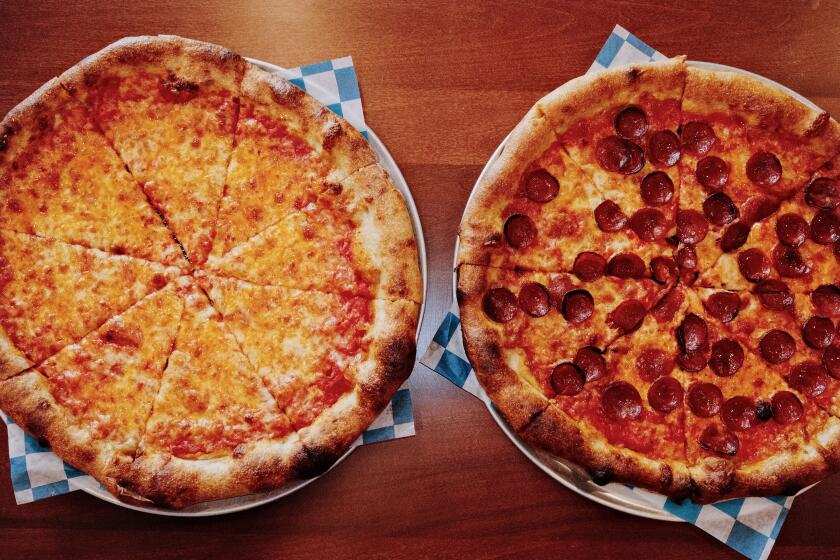Review: Jonathan Gold says hello from Tokyo, where there are cherry blossoms and, even better, Narisawa
If you want to understand why Narisawa is often considered to be among the best restaurants in the world, you might have a look at Satoyama Scenery, a kind of seven square inches of edible forest floor that is constructed from sprigs of mountain herbs, a scattering of cherry blossoms, rough cylinders of fish skin and roots transformed into what look like fallen twigs, and a powdery tumble of earth and mosses fashioned from pulverized grains, fermented soybeans and a bit of matcha tea.
The tableau is assembled on a slice of raw log, more bark than planed surface. A small bamboo jigger brims with cold, oak sap-seasoned water — what you imagine raindrops sipped from fallen leaves might taste like. On a cloudy glass plinth nearby, three delicately fried ayu, glazed with cherry-blossom essence, swim in a formation familiar from woodblock prints. And while you are near the center of Tokyo, in a modernist restaurant hidden in a rear courtyard of an office complex, your mind is, at least for the moment, in the mountainous countryside, at that nexus between civilization and nature — satoyama — that is at the center of so much Japanese literature and art.
Am I out of town again? I am, and I apologize.
Tokyo in cherry-blossom time is an idea I had always rolled my eyes at a little, the idea of a great world city paused for a week or two while its residents picnicked in Ueno Park, took slow river cruises or three subway lines to the corner of the Imperial Palace compound where the blossoms grew most thickly. Then you get there and you become like all the rest — traveling to shrines, gobbling mochi and chocolate and broths flavored with the blossoms, walking down cobbled backstreets while petals whirl around you like pale, pink snow.
Yoshihiro Narisawa was raised in rural Japan, cooked with Paul Bocuse and Joël Robuchon in France, and returned to open a French restaurant that gradually became more Japanese. His restaurant has been the site of chef pilgrimages at least since he moved it from Odawara to Tokyo 15 years ago, and at least a few techniques, notably those tableaux and maybe vegetable ash as seasoning, may have been nudged into popularity in his kitchens. Like the most accomplished modernist chefs, he is as familiar with the nuances of liquid nitrogen as he is with the guy who farms his quail.
So that fried capsule of pounded Japanese yam is filled with a smear of sea urchin roe; the soft-shelled turtle is served both as herb-flecked broth and formed into patties skewered on fragrant, smoldering branches; and a grilled filet of Yamaguchi tilefish is crusted with crushed rice crackers and served on a puddle of demi-chowder thick with Hokkaido crab.
The first thing presented to you when you sit down, even before the tiny saucer of sake, is a drinking glass of dough that rises and mushrooms like a yeasty phallus during the course of the meal. The server now scrapes lumps of the risen dough into a hot stone pot. It is transferred to a cart. Twelve minutes later, he puts it onto a plate next to what resembles a fuzzy green rock. It is bread. The rock is moss-coated butter.
There is a quail with a creamy burdock emulsion — the woods again — and then a steamed langoustine, with the licking and sucking and tearing that you realize may be the first bit of animal pleasure in the rather intellectual meal. Scallops are showered with a pink fog of crushed, frozen cherry blossoms poured from a liquid nitrogen-chilled cylinder, and you shudder with pleasure.
Is there blowfish with baby fava beans? Did you enjoy the shellfish in a broth made from extra-aged kombu seaweed, and did it vibrate with umami?
It is hard to remember. But here is a chunk of A-5 Wagyu beef, crusted with leek ash, presented first as a lump of charcoal and then as a sliced piece of meat. You are instructed how best to Instagram the meat. You are told which of the dots surrounding it is bordelaise sauce, which is flavored with sansho pepper, which is (of course!) made with cherry blossoms. By the time he has finished speaking, you may be halfway into your steak. And you will be all the way into early spring.
Food Bowl Alert: Chef Yoshihiro Narisawa will be featured on the first day of this year’s Los Angeles Times Food Bowl. On May 1, he will participate in a lunch and Q&A session at Orsa and Winston with photographer Sergio Coimbra and Jonathan Gold from 12:30 p.m. to 2:30 p.m.; tickets are $95. If you can’t make that, be sure to stop by Union Station anytime in May to see an exhibition about the dishes he’s created, ingredients he uses, and his partnership with farmers.
Narisawa
Minami Aoyama 2-6-15, Minato-ku, Tokyo
+81-3-5785-0799
Food Bowl Alert: Chef Yoshihiro Narisawa will be featured on the first day of this year’s Los Angeles Times Food Bowl. On May 1, he will participate in a lunch and Q&A session at Orsa and Winston with photographer Sergio Coimbra and Jonathan Gold from 12:30 p.m. to 2:30 p.m.; tickets are $95. If you can’t make that, be sure to stop by Union Station anytime in May to see an exhibition about the dishes he’s created, ingredients he uses, and his partnership with farmers.
More to Read
Eat your way across L.A.
Get our weekly Tasting Notes newsletter for reviews, news and more.
You may occasionally receive promotional content from the Los Angeles Times.











